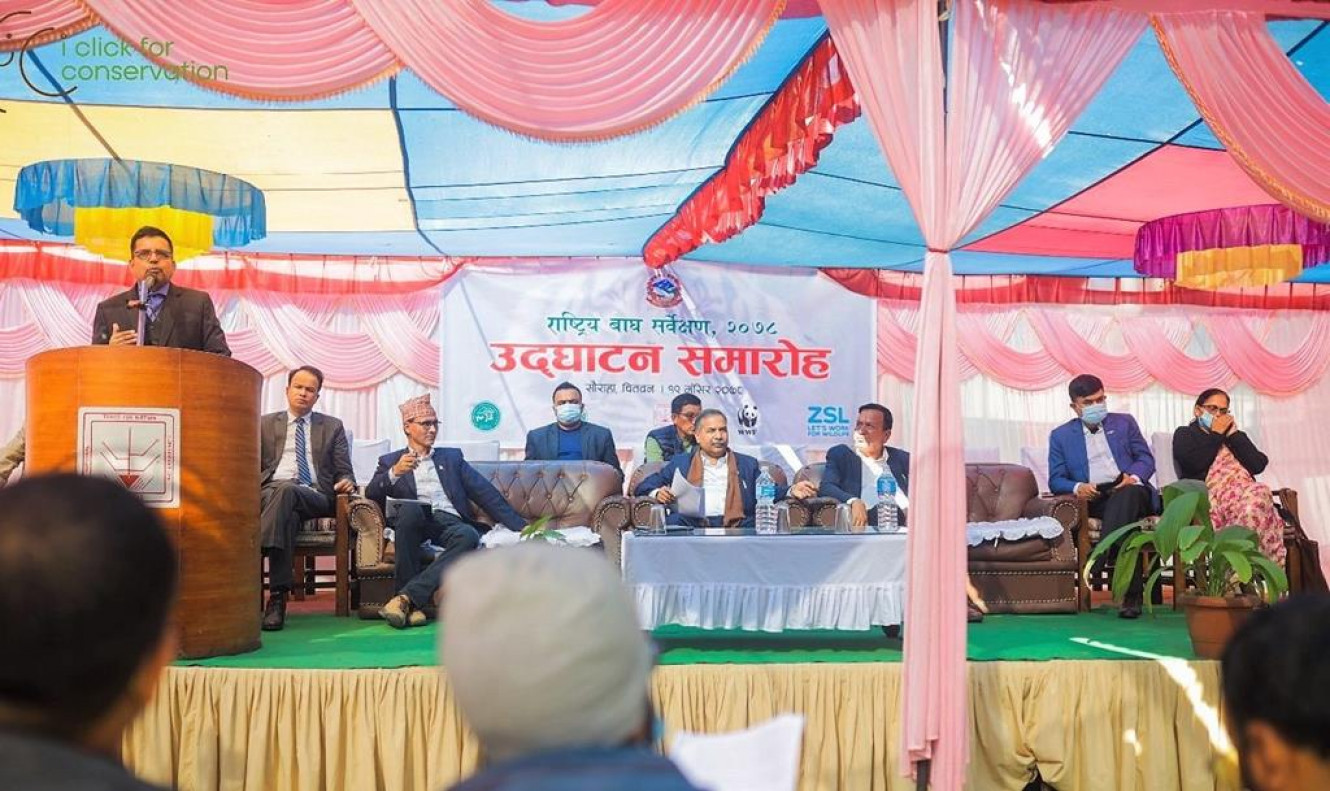
The national tiger survey 2021-22 has officially commenced. An inauguration programme marking the occasion was organized yesterday (5 December) with the Hon. Minister for Forests and Environment (MOFE), Mr Ramsahay Prasad Yadav installing a camera trap pair at the NTNC-Biodiversity Conservation Center complex area in Sauraha, Chitwan. The event was held in the presence of the MOFE Secretary Dr Pem Narayan Kandel and was chaired by Dr. Ramchandra Kandel, the Director General of the Department of National Parks and Wildlife Conservation (DNPWC), the lead entity responsible for carrying out the national assignment. Other special guests at the inauguration also included the mayor of Ratnanagar Municipality, Chitwan, Director General of the Department of Forests and Soil Conservation (DoFSC), the NTNC Member Secretary, Country Representatives of WWF Nepal and ZSL Nepal, together with local leaders, buffer zone area members and community representatives.
The tiger survey will be conducted in accordance with the Tiger and Prey Base Monitoring Protocol 2017. For this tiger bearing areas have been divided into three major complexes—Chitwan-Parsa, Banke-Bardiya, and Shuklaphanta-Laljhadi-Jogbudha. Camera trapping and occupancy survey methods will be applied using camera traps, along with Santo compasses, range finders, GPS, recorders, among other equipment. The total camera trap coverage area of the survey alone will be more than 7500 sq. km. In the Chitwan-Parsa complex for instance the survey will be divided into three sub-blocks, Tribeni-Dauney-Sauraha, Sauraha-Manahari, and Manahari-Bagmati, which will include about 900 grids, each measuring 4 sq. km, where a pair of camera trap will be installed in each grid for at least fifteen days.
Prior to the census inauguration a three-day training has already been conducted at the NTNC-BCC facility for more than 100 enumerators and technicians who will be mobilized for the camera trap deployment, monitoring and collection. The national survey will take at least four months before the final tiger population status can be determined.
[READ: STATUS OF TIGERS AND PREY IN NEPAL 2018]
Technical staff of national parks, staff of division forest office, wildlife technicians of NTNC, wildlife experts, Nepal Army personnel, local community members, staff of conservation partner organizations and volunteers are also being mobilized on the ground. To ensure effective coordination of the overall process, a steering committee has been formed at the central level consisting of the DNPWC Director General, the DoFSC Director General, Directorate of National Parks and Reserves, Chief of the Nepal Army, the NTNC Member Secretary, and Country Representatives of WWF Nepal and ZSL Nepal. The survey is estimated to cost about NPR 37 million. Besides the government's budget allocation, NTNC, WWF Nepal and the ZSL Nepal will be providing additional technical and financial support.
This is Nepal's fourth national tiger survey since 2009-10. The country has received global recognition for its tiger doubling efforts, from 121 tigers in 2009 to 198 in 2013, and most recently to 235 tigers in 2018. Keeping with its commitment to the Global Tiger Recovery Plan (TX2), which was endorsed by 13 tiger-range countries, during the 2010 Saint Petersburg Declaration on Tiger Conservation, Nepal targets to double its tiger population to 250 tigers by 2022.
[cover photo by: Sagar Giri, Sauraha, Chitwan]
